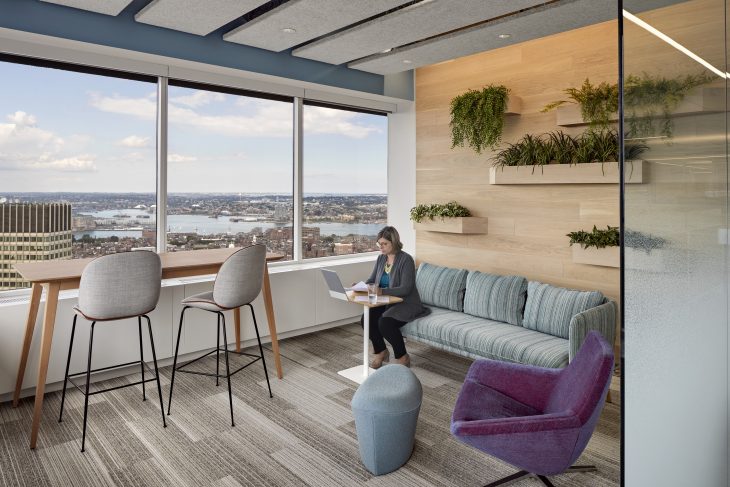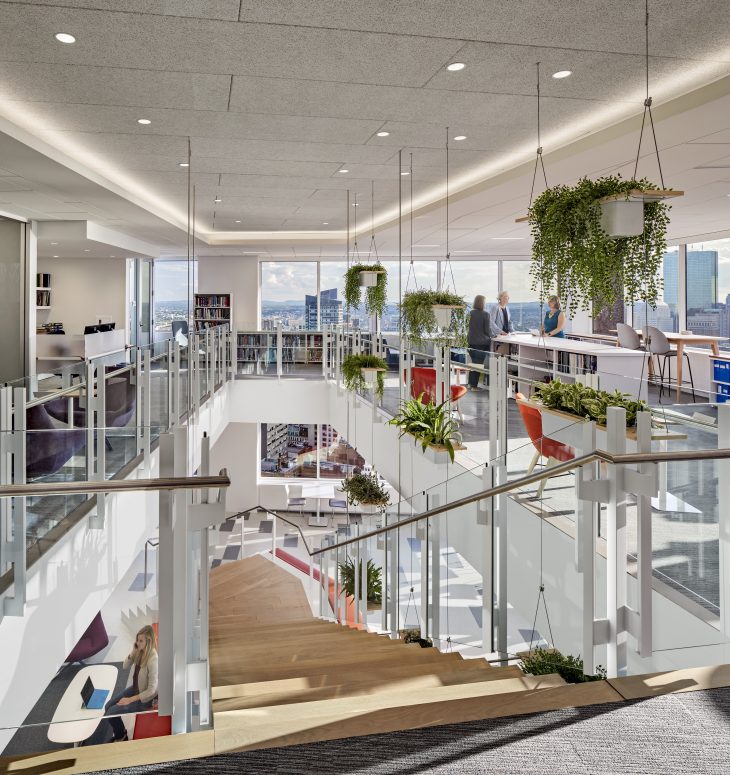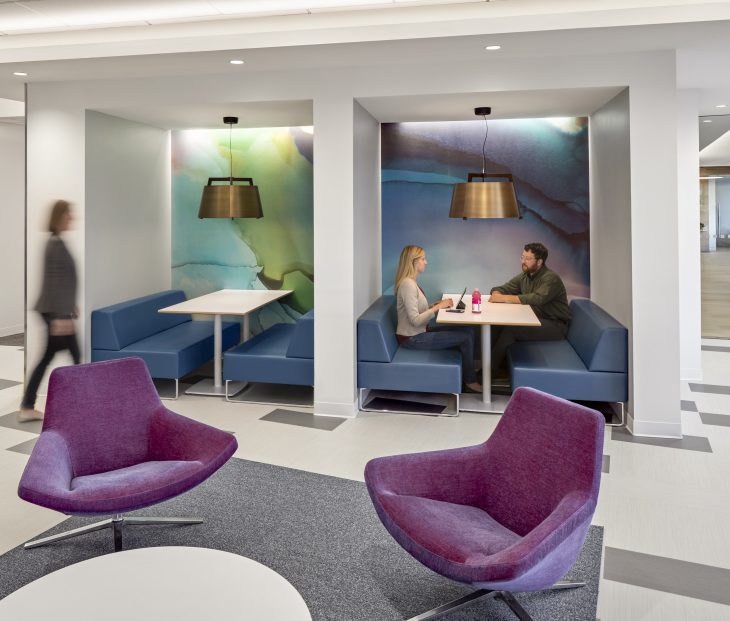While the pendulum continues to swing, how design stands to leverage what matters most in the workplace is much more complex than the partitioning of space.

The debate on the presence or absence of barriers between people in the office continues to drive how we as an industry discuss the impact of design on workplace behavior. Barriers, or the lack thereof, are perceived as having the potential to monumentally shape everything from employee communication and culture to wellness and efficiency.
At one end of the design spectrum is the traditional office layout characterized by assigned, enclosed offices, conference rooms grouped front and center near the entrance, standalone cafeterias and siloed print resource areas. Born from the hype around the successes of co-working, at the other end is the “free address” approach where employees build their workspaces anew each day via a first-come-first-serve policy. Both strategies, which aren’t without their merits, have faced significant user backlash; the traditional office has been perceived as maintaining corporate hierarchy and the “free address” model as adding an element of unnecessary uncertainty and stress to the workday.

While the pendulum continues to swing, how design stands to leverage what matters most in the workplace is much more complex than the partitioning of space. Factors like efficiency, wellness and connectivity can instead be improved upon by one simple driving force: access to resources, with one of the primary objectives of “good” design being convenience. That’s where the “50 feet” concept comes in.
The “50 feet” approach reimagines the organization and availability of shared office resources and space. It seeks to ensure that every human, material and wellness-related resource an employee needs is within 50 feet of their individual workspace. If you were to view the application of this concept from a bird’s eye view, the floorplan would resemble individual honeycombs within a hive; a series of self-sufficient clusters that when combined form a whole community.
How Proximity Fosters Employee Interaction
Despite the rise of online messaging platforms like Slack and Google Hangouts, about 80 percent of communication is still non-verbal. In the work environment, where human relationships are conventionally structured according to a hierarchy, face-to-face interaction is a critical component of cultivating efficiency, not to mention team loyalty and company culture.
Spatial organization should encourage employees to engage and trade ideas naturally and spontaneously. The amount of time it takes for someone to peek over a neighboring cubical wall, walk 15 feet to talk to a manager or spark conversation across a table is little to none. When someone is considering whether or not they want to share a thought or idea, time can be the deciding factor, even if the amount of time in question represents only a few seconds. A tactile exchange like this, however, has the potential to propel a project forward, inject creativity into a stagnant thought-process, advance peer mentorship or strengthen workplace bonds. Grouping team members no further than 50 feet from each other makes communication effortless, ultimately saving time and energy, while promoting a more creative and open environment.
Smaller design techniques can further promote off-the-cuff collaboration. Placing a couple of chairs or unassigned worktables in transition areas, such as hallways or underutilized nooks, allows momentary exchanges to grow and settle into something more.

How Access to Daily Resources Reduces Stress
An employee’s ability to quickly take advantage of office materials is extremely valuable in that it lowers personal stress, boosts productivity and reduces inefficiencies. Whether it’s a private phone booth, printer area, breakout station or coffee bar intended for casual use between tasks, placing creative, physical and social resources near employees leads to their use. Since it may be unreasonable to assume there are multiples of certain resources, such as printing stations, in smaller offices, strategically designing departments to address their unique day-in and day-out needs can ensure that available materials are being put to good use. For instance, placing phone booths near the sales department makes more sense than huddling them near the graphic design team.
This approach, used to inform the design of an office that we recently completed for The Brattle Group in Boston, continues to foster daily efficiency that is beneficial to employees and attractive to prospective hires.
“The proximity design implemented in our space has improved productivity and reduced foot traffic by seating teams close to each other, distributing the conference rooms near work areas and offering alternative working places, such as the café, workout room and library,” said Metin Celebi, Principal at The Brattle Group. “The design definitely impresses candidates quite a lot when they come in for interviews and our employees seem more content.”
Independent of the closed or open nature of an office’s floorplate, distributing resources throughout can also foster a sense of egalitarianism. Placing community tools within the reach of employees at all levels conveys that everyone is expected to benefit from their use.
How Boosting Access to Natural Elements Creates Wellness without a Second Thought
Corporate wellness is achieved when it’s seamlessly woven into people’s day-to-day routines. Dispersing natural elements and amenities throughout an office floorplan, such as common seating areas near windows, workout rooms, biophilia and welcoming eating stations, is a subtle way to ensure that the built ecosystems employees interact with enhance their mental and physical wellbeing.

A great way to accomplish this is to guarantee that areas with natural light are designed for communal use, rather than sectioned off for leadership or client-facing purposes. For instance, at The Brattle Group’s headquarters, we designed the café, lounge and game room along the wall that had the best views of the city. This ensured that all employees could take advantage of the sights in their downtime or while working away from their desk.
Pulling aspects of the outdoors in can also stimulate a change in mindset and drive productivity by allowing the mind to shift in focus. Installing features or accents that aren’t common in traditional offices, such as hanging plants along a highly-trafficked stairway, is a simple way to inspire a mental reset. It’s also easy to boost wellbeing by learning what employees need most and setting aside space for that, whether it be complete silence, a no tech zone, or a meditation area. Transforming small rooms into places with a community-understood purpose demonstrates a prioritization of equilibrium, while also providing the space to reach it.
Moving Forward
Speaking with clients about a new approach to the office layout isn’t always easy. Companies often make design decisions based on their existing spaces, the furniture they currently possess or preconceived notions about what works and what doesn’t. As a designer, it’s essential to talk to the client’s staff directly in order to truly understand their needs and wants. These insights can then be utilized to design a tailored environment that fosters spatial convenience and addresses pre-existing issues. Always remember, the most obvious solution may not be the right one. It’s vital that you work with each client to address their needs in a creative and impactful way.



[…] Work Design Magazine recommends ensuring that “areas with natural light are designed for communal use, rather than […]
[…] Work Design Magazine recommends ensuring that “areas with natural light are designed for communal use, rather than […]